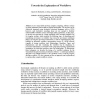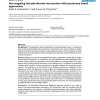26 search results - page 3 / 6 » Causes and Explanations: A Structural-Model Approach - Part ... |
EXACT
2009
13 years 3 months ago
2009
Across many fields involving complex computing, software systems are being augmented with workflow logging functionality. The log data can be effectively organized using declarativ...
ECAI
2008
Springer
13 years 7 months ago
2008
Springer
This paper describes a novel method for explaining Bayesian network (BN) inference when the network is modeling a population of conditionally independent agents, each of which is m...
BMCBI
2008
13 years 6 months ago
2008
Background: The identification and characterization of interacting domain pairs is an important step towards understanding protein interactions. In the last few years, several met...
ACL
1998
13 years 7 months ago
1998
Starting from descriptions of French connectives (in particular "donc"---therefore), on the one hand, and aspectual properties of French tenses pass4 simple and imparfai...
KDD
1994
ACM
13 years 10 months ago
1994
ACM
We applied TETRAD II, a causal discovery program developed in Carnegie Mellon University's Department of Philosophy, to a database containing information on 204 U.S. colleges...


